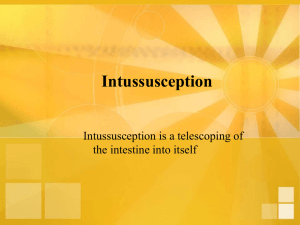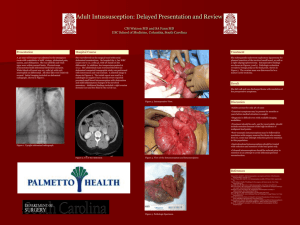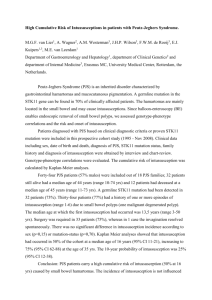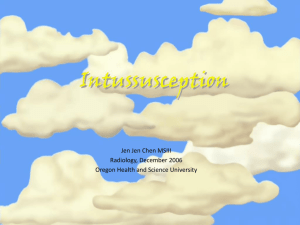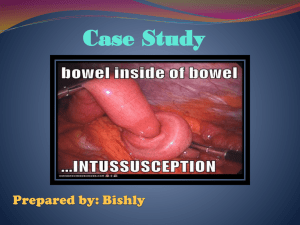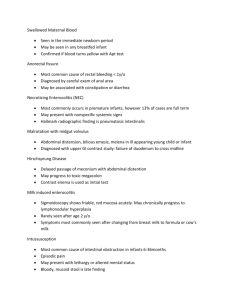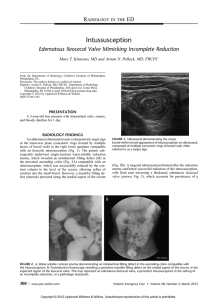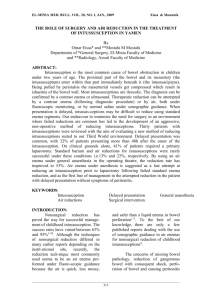Intussusception
advertisement
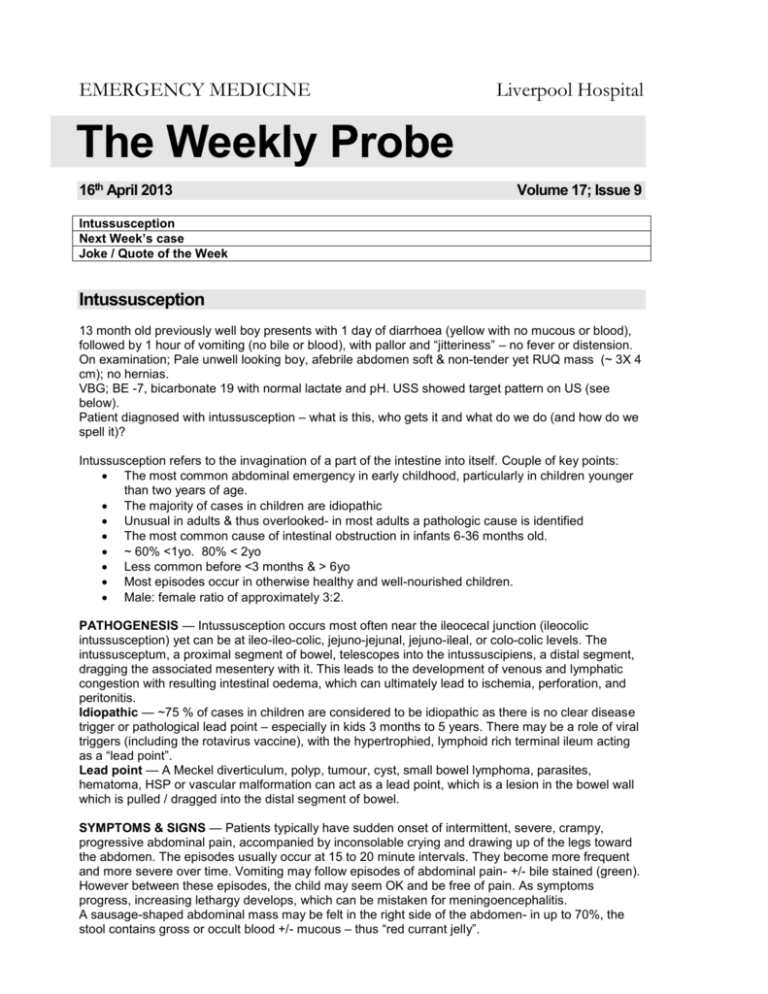
EMERGENCY MEDICINE Liverpool Hospital The Weekly Probe 16th April 2013 Volume 17; Issue 9 Intussusception Next Week’s case Joke / Quote of the Week Intussusception 13 month old previously well boy presents with 1 day of diarrhoea (yellow with no mucous or blood), followed by 1 hour of vomiting (no bile or blood), with pallor and “jitteriness” – no fever or distension. On examination; Pale unwell looking boy, afebrile abdomen soft & non-tender yet RUQ mass (~ 3X 4 cm); no hernias. VBG; BE -7, bicarbonate 19 with normal lactate and pH. USS showed target pattern on US (see below). Patient diagnosed with intussusception – what is this, who gets it and what do we do (and how do we spell it)? Intussusception refers to the invagination of a part of the intestine into itself. Couple of key points: The most common abdominal emergency in early childhood, particularly in children younger than two years of age. The majority of cases in children are idiopathic Unusual in adults & thus overlooked- in most adults a pathologic cause is identified The most common cause of intestinal obstruction in infants 6-36 months old. ~ 60% <1yo. 80% < 2yo Less common before <3 months & > 6yo Most episodes occur in otherwise healthy and well-nourished children. Male: female ratio of approximately 3:2. PATHOGENESIS — Intussusception occurs most often near the ileocecal junction (ileocolic intussusception) yet can be at ileo-ileo-colic, jejuno-jejunal, jejuno-ileal, or colo-colic levels. The intussusceptum, a proximal segment of bowel, telescopes into the intussuscipiens, a distal segment, dragging the associated mesentery with it. This leads to the development of venous and lymphatic congestion with resulting intestinal oedema, which can ultimately lead to ischemia, perforation, and peritonitis. Idiopathic — ~75 % of cases in children are considered to be idiopathic as there is no clear disease trigger or pathological lead point – especially in kids 3 months to 5 years. There may be a role of viral triggers (including the rotavirus vaccine), with the hypertrophied, lymphoid rich terminal ileum acting as a “lead point”. Lead point — A Meckel diverticulum, polyp, tumour, cyst, small bowel lymphoma, parasites, hematoma, HSP or vascular malformation can act as a lead point, which is a lesion in the bowel wall which is pulled / dragged into the distal segment of bowel. SYMPTOMS & SIGNS — Patients typically have sudden onset of intermittent, severe, crampy, progressive abdominal pain, accompanied by inconsolable crying and drawing up of the legs toward the abdomen. The episodes usually occur at 15 to 20 minute intervals. They become more frequent and more severe over time. Vomiting may follow episodes of abdominal pain- +/- bile stained (green). However between these episodes, the child may seem OK and be free of pain. As symptoms progress, increasing lethargy develops, which can be mistaken for meningoencephalitis. A sausage-shaped abdominal mass may be felt in the right side of the abdomen- in up to 70%, the stool contains gross or occult blood +/- mucous – thus “red currant jelly”. However, the classically described triad of pain, mass and currant-jelly stool is seen in < 15% at the time of presentation. Some quote up to 20 percent of young infants have no obvious pain, & ~ 1/3 do not pass blood or mucus or develop an abdominal mass. Many older children have pain alone without other signs or symptoms. Occasionally, the initial presenting sign is lethargy or altered consciousness alone, without pain, rectal bleeding, or other symptoms that suggest an intraabdominal process- this presentation primarily occurs in infants, and is often confused with sepsis. Thus, intussusception should be considered in the evaluation of otherwise unexplained lethargy or altered consciousness, especially in infants. An older paediatric surgeon once described intussusception as the “syphilis of paediatrics”, nothing to do with lifestyle, but in that it has many varied manifestations so consider it on your differential diagnoses for a number of presentations. DIAGNOSIS —The optimal strategy for diagnosis and treatment depends on the clinical suspicion for intussusception (typical or atypical presentation) and on the preference and experience of the consulting radiologists. Patients with a typical presentation (e.g., infant or toddler with sudden onset of intermittent severe abdominal pain with or without rectal bleeding) may proceed directly to non-operative reduction using hydrostatic (contrast or saline) or pneumatic (air) enema, performed under either sonographic or fluoroscopic guidance. In these cases, the procedure is both diagnostic and therapeutic. For many other patients, the diagnosis is unclear at presentation. In this case, initial workup may include abdominal ultrasound or abdominal plain films, provided that these studies do not significantly delay the definitive treatment of intussusception. If the study supports the diagnosis of intussusception, nonoperative reduction is then performed. Ultrasonography — Ultrasonography is the method of choice to detect intussusception in some hospitals – good sensitivity and specificity, able to detect pathological lead points, can be used to monitor the success of a reduction procedure, and does not expose the patient to radiation. In other institutions, fluoroscopy is used as the primary diagnostic procedure for intussusception. The classic ultrasound image of intussusception is a target sign with transverse sonography of the mass reveals a swirled pattern of alternating hyperechogenicity and hypoechogenicity representing the layers of mucosa, muscularis, and serosa (target or doughnut sign)- see below. Longitudinal sonography reveals a sandwich like appearance of the alternating loops of bowel - a lack of perfusion in the intussusceptum may also indicate the development of ischemia. – it can also help determine the length of the intussuceptum, as measured by ultrasound, which may determine prognosis and management. Editor: Peter Wyllie Abdominal Plain Film; Plain X-rays are less sensitive and less specific than USS. Findings include: A soft tissue mass (78%) especially right paraspinal region. It is sometimes called a pseudo-kidney sign because it may have the shape of an oval mass in the RUQ. A target sign, consisting of two concentric radiolucent circles superimposed on the right kidney, represents peritoneal fat surrounding and within the intussusception- similar in appearance to the US image above - noted in 26% of patients in one report. A soft tissue density projecting into the gas of the large bowel (representing the intussusception) is called the "crescent sign." (~30%)- see curved line below. Although rarely seen, the presence of pneumoperitoneum suggests that bowel perforation has occurred. Absent liver edge sign (also called absence of the subhepatic angle) Evidence of bowel obstruction – bowel distension with fluid levels may be seen late – look for loss of plications and haustrations of the bowel, which results in a smooth hose-like or sausage-like appearance results. Another term described when looking at evidence of a bowel obstruction is orderliness- best appreciated on the supine view. In this case, the gas pattern is orderly rather than disorderly. In other words, it resembles a bag of sausages more so than a bag of popcorn. The orderly (bag of sausages) appearance is more indicative of a bowel obstruction. The presence of air in the caecum on at least two views had high sensitivity for excluding intussusception in this patient population with a low clinical suspicion of disease (sensitivity 96 percent). However most importantly -do not recommend relying on plain radiography to exclude intussusception if there is a significant clinical suspicion of the disease. Diagnostic enema often demonstrates the meniscus sign (convex intracolic mass) where the rounded apex of the intussusceptum protrudes into the contrast column. The "coiled spring" sign is Editor: Peter Wyllie oedematous mucosal folds of returning limb of intussusceptum outlined by contrast material within the lumen of colon. CT scan — An intussusception can be recognized on computed tomography (CT), which may also identify the cause especially in adults- not therapeutic. TREATMENT — Stable patients with a high clinical suspicion and/or radiographic evidence of intussusception (especially if ileocolic) and no evidence of bowel perforation should be treated with nonoperative reduction - this involves using hydrostatic or pneumatic pressure by enema- success in 80-95%. Non-operative reduction risks – post reduction fever / recurrence ~ 10% / perforation ~ 1% (esp. <6 months old, long duration of symptoms (e.g., 3 days or longer), evidence of small bowel obstruction, use of higher pressures) Before attempting reduction by enema, the patient should be stabilized and resuscitated with IV, and consider a NGT. Surgical treatment is indicated as a primary intervention for patients with suspected intussusception who are acutely ill or have evidence of perforation (peritonism or free gas). Surgery also may be appropriate when the patient is treated in a location where the radiographic facilities and expertise to perform nonoperative reduction are not readily available. Surgery also may be necessary for patients in whom nonoperative reduction is unsuccessful, or for evaluation or resection of a pathological lead point. Patients with intussusception limited to the small bowel (ileo-ileal, jejuno-ileal, or jejuno-jejunal) are less likely to be reduced non-operatively, and if short (< 2.3 cm long) are more likely to reduce spontaneously. NEXT WEEK’S CASE A 65-year-old man presents with dyspnoea ~ 2 weeks post CABGs. He has no chest pain and is afebrile. On CXR he has a large pleural effusion. Upon inserting a pleurocath, you note the drainage of a large amount of turbid “salmon “ coloured fluid. What is this and how do you treat it? JOKE / QUOTE OF THE WEEK Editor: Peter Wyllie Editor: Peter Wyllie
